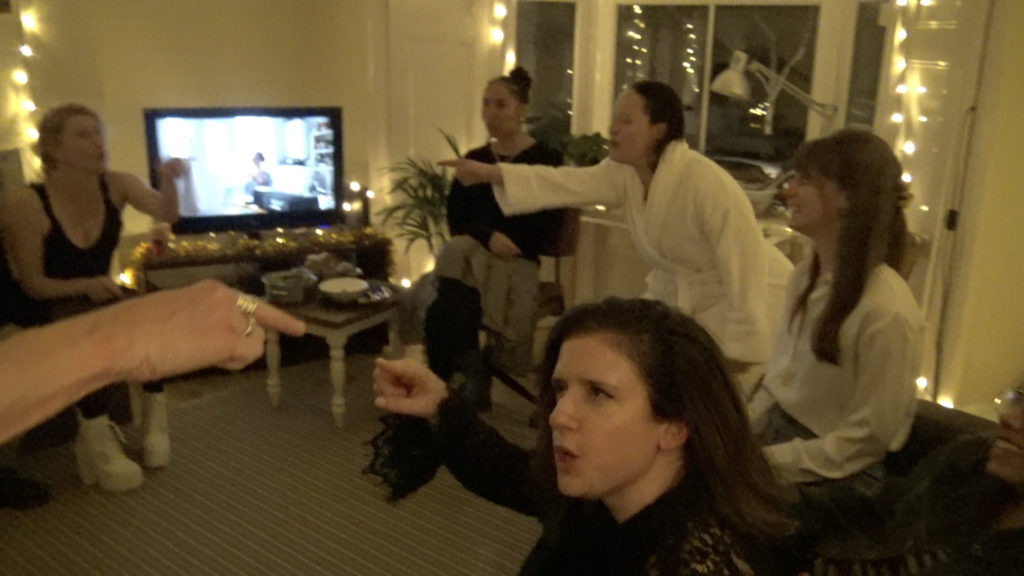Words by Maxine Flasher-Duzgunes.
A month ago, I sat down with the creatives behind “We Move in Close Circles,” a performance experience taking place in people’s homes that over the course of the night morphs between a dinner party, a therapy session, a musical number, and a fight scene inspired by The Real Housewives…
The work began over the creatives’ occasional meetings in different places – sometimes cafés, or studios, the Southbank Centre – and involved a long period of research on the “problem conversation” or otherwise a fake argument without a reason or any content whatsoever. “Our first rehearsals were about reenacting very everyday interpersonal encounters. We loved treating them as these really significant or dramatic moments, even though they were so banal,” says collaborator Rohanne Udall.
“We didn’t want the content of the work to be about art-making or performance. But then we ended up being interested in having arguments that didn’t seem to be about anything at all,” she continues. “When rehearsing and playing together, we started to develop this very bitchy and passive-aggressive patter or banter between us that could continue endlessly.”
“As performers, we seem to be saying all the right things, and making all the right gestures, but clearly we’re complete narcissists.”
Paul Paschal
The other aspect was the group would consistently practise without institutional dependency, and also wouldn’t charge for tickets at their events. “We were interested in what it means to create work that can exist outside of institutions and reach audiences outside of those institutions,” says Paul Paschal. The fewer expectations, the more the work could be defined as a hybrid between a performance and social gathering, transforming the understanding of the owner’s household space.

“It’s a sandwich of performance and socialising. We end up getting to know the friends of the hosts who have come to see the show. It makes it a bit more immersive than being fully contrived or controlled performance,” says Orley Quick. It becomes a unique situation to bring people together, especially when the interactions occurring within this person’s home are both real and simulated. Per the title, “close circles” are essentially the people coming to see the work, who are exclusively invited by the homeowner.
“The work kind of instils FOMO,” says Sam Pardes, or in other words, ‘the fear of missing out.’ “I think it’ll just generate more and more, the longer that we go, the more it becomes something that people recognise, because it’s so elusive and so difficult to track.”
Due to the limited audience, the piece is always interrogating this question of intimacy and the sense of belonging people feel when in a home environment that exposes the ugly underbelly of domesticity. And it’s even more interesting to consider the people who hear about the performance but never get to see it, and how the circles of people affected continue to widen even when there are few in the room to experience it.
“It’s the viciousness that can be in the most mundane human interactions,” says Rohanne. And with that comes the role of the camera, which in reality television manages to record both the welcoming and ruthless edge to every conversation. The camera is introduced non-verbally at the door during the guests’ arrival window, and is handed between guests and performers throughout the night like both a form of technology to hide behind and an instrument of vanity. At a certain point, the audience watches archival footage of this group’s process, but the opportunity to view footage taken that night is never provided by the cast.
“I find the camera interesting as an object in the performance,” says Paul, because many of the performers are constantly looking at it. “These people seem to be engaging with one another with a sense of care, but it’s really all for another audience, and for some future capital that they can acquire. It’s a really important dynamic throughout the piece. As performers, we seem to be saying all the right things, and making all the right gestures, but clearly we’re complete narcissists.”

The group admits how the performance refines itself as they keep working on it, and that there is this constant curiosity for the process as it sharpens. The piece circles in a vacuum, navigating this seemingly never-ending game of rhetoric interspersed with quirky relationship-building over singing, eating, dancing, and filming. Perhaps it was never meant to exist in a theatre at all…
The ability to hold tension and then release it at the right moments is a bit like a detailed orchestration, and the show has gone on amidst the interruption of drunk guests, reactive dogs, even broken glass. Altering themselves for these in-home performances has proven more of a fine art than the opera, and only the future will tell what further disruptions might change the course of each night. But the cast handles these with grace, despite their faux back-and-forth brawls.
“One of the other major threads of the work is friendship,” continues Paul. “We’re horrible to each other. But then the audience gets to see some footage of us being horrible to each other for five or ten years. And staying together for that long means something.”
For more information on their work and future performances, visit: https://currentname.info/we-move/.
